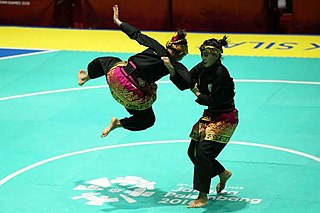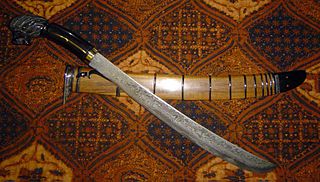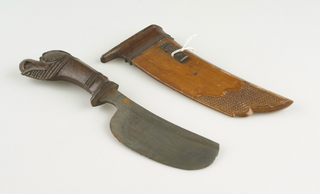Related Research Articles

Banten is the westernmost province on the island of Java, Indonesia. Its capital city is Serang and its largest city is Tangerang. The province borders West Java and the Special Capital Region of Jakarta on the east, the Java Sea on the north, the Indian Ocean on the south, and the Sunda Strait on the west and shares a maritime border with Lampung to the west. The province covers an area of 9,352.77 km2 (3,611.12 sq mi). It had a population of over 11.9 million in the 2020 census, up from about 10.6 million in 2010. The estimated mid-2023 population was 12.308 million. Formerly part of the province of West Java, Banten was split off to become a province on 17 October 2000.

Silat Melayu, also known as Seni Persilatan Melayu or simply Silat, is a combative art of self-defence from the Malay world, that employs langkah ('steps') and jurus ('movements') to ward off or to strike assaults, either with or without weapons. Silat traced its origin to the early days of Malay civilisation, and has since developed into a fine tradition of physical and spiritual training that embodies aspects of traditional Malay attire, performing art and adat. The philosophical foundation of modern Malay Silat is largely based on the Islamic spirituality. Its moves and shapes are rooted from the basis of Silat movements called Bunga Silat, and Silat performances are normally accompanied with Malay drum assembles.

Kuntao or kuntau is a Hokkien term for the martial arts of the Chinese community of Southeast Asia, specifically the Malay Archipelago. It is most commonly practiced in and associated with Indonesia, Malaysia, the Philippines and Singapore.

The culture of Indonesia has been shaped by the interplay of indigenous customs and diverse foreign influences. With over 1,300 distinct ethnic groups, including significant Austronesian and Melanesian cultures, contributing to its rich traditions, languages, and customs, Indonesia is a melting pot of diversity. Positioned along ancient trade routes between the Far East, South Asia, and the Middle East, the country has absorbed cultural practices influenced by Hinduism, Buddhism, Confucianism, Islam, and Christianity. These influences have created a complex cultural tapestry that often differs from the original indigenous cultures.

A golok is a cutting tool, similar to a machete, that comes in many variations and is found throughout the Malay Archipelago. It is used as an agricultural tool as well as a weapon. The word golok is used in Indonesia and Malaysia. Both in Malaysia and in Indonesia, the term is usually interchangeable with the longer and broader parang. In the Sundanese region of West Java it is known as bedog. In the Philippines, the term gulok, refers to different dagger weapons including the kris.

Nasi uduk is an Indonesian-style steamed rice cooked in coconut milk dish, especially popular in Betawi cuisine.

Pencak silat is an umbrella term for a class of related Indonesian martial arts. In neighbouring countries, the term usually refers to professional competitive silat. It is a full-body fighting form incorporating strikes, grappling, and throwing, in addition to weaponry. Every part of the body is used and subject to attack. Pencak silat was practiced not only for physical defense but also for psychological ends. There are hundreds of different pencak silat styles and schools which tend to focus either on strikes, joint manipulation, weaponry, or some combination thereof.

Betawi people, Batavi, or Batavians, are an Austronesian ethnic group native to the city of Jakarta and its immediate outskirts, as such often described as the inhabitants of the city. They are the descendants of the people who inhabited Batavia from the 17th century onwards.
Silat is a generic name for the martial arts of certain countries in Southeast Asia. There is untold number of Silat systems in Maritime Southeast Asia, with there being over 150 styles recognized styles of pencak silat in Indonesia, and more in aboard.

Kemayoran is a district (kecamatan) of Central Jakarta, Jakarta in Indonesia. It was best known for the former Kemayoran Airport and it has been transforming as a new central business district. As of 2023, it consists of numerous four and five-star hotels, restaurants, premium office towers, hospitals as well as shopping and entertainment centers. Kemayoran is also home to the Jakarta Fair, the largest and longest fair in Southeast Asia that attracts more than 4 million visitors annually.

Silat is the collective term for a class of martial arts from the Nusantara and surrounding geocultural areas of Southeast Asia. It is traditionally practised in Brunei, Indonesia, Malaysia, Singapore, Southern Thailand, Southern Philippines and Southern Vietnam. There are hundreds of different styles (aliran) and schools (perguruan) which tend to focus either on strikes, joint manipulation, weaponry, or some combination thereof.

Ali bin Abdurrahman al-Habshi, better known as Habib Ali of Kwitang or Habib Ali Kwitang, was one of the leading Islamic clerics and preachers in Jakarta in the 20th century. He was also the founder and chairman of the Majelis Taklim Kwitang and Islamic Center Indonesia, which are the forerunners of other religious organizations in Jakarta.

Indonesian martial arts includes a variety of fighting systems native to or developed in the archipelago of Indonesia, both the age-old traditional arts, and the more recently developed hybrid combatives. In the Indonesian language the term bela-diri is used to mean martial art, and in essence the Indonesian fighting arts are meant as one's defence against perceived threat and assault. Other than physical training, they often include spiritual aspects to cultivate inner strength, inner peace and higher psychological ends.

It is quite difficult to define Indonesian art, since the country is immensely diverse. The sprawling archipelago nation consists of 17,000 islands. Around 922 of those permanently inhabited, by over 1,300 ethnic groups, which speak more than 700 living languages.
Kyai Hajji Abdul Fatah Hasan, better known as Ki Fatah Hasan was an Islamic scholar and fighter for Indonesian Independence. Hasan was also a member of the Investigating Committee for Preparatory Work for Independence (BPUPK) which began meeting on 10 July 1945, after the addition of 6 members of the Indonesian nation at the second hearing.
Beksi Silat is one of the most popular traditional martial arts of the Betawinese. This kuntao-silat hybrid style was originally developed in Kampung Dadap, a village in Kosambi district of Tangerang Regency, Banten Province, Indonesia. The founder of this style combined elements of his ancestral Chinese martial arts with the silat knowledge he received from his Betawi teachers. The style spread through his disciples to the coastal Betawinese and the Benteng Chinese around Kampung Dadap. Eventually, the silat style also reached Petukangan Selatan in South Jakarta and Batujaya in Tangerang.
Cingkrik Silat is one of the traditional pencak silat styles of the Betawinese. This style originally came from the Rawa Belong area, which is now part of the Kebon Jeruk subdistrict, West Jakarta, Indonesia. This style was created by Ki Maing around the 1920s. Cingkrik Silat has now been spread to various places in Jakarta through many silat schools opened by its practitioners.
Perguruan Silat Mustika Kwitang, or simply called Kwitang silat, is a Betawinese pencak silat style. It was originally developed in the Kwitang village, which is now part of the Senen subdistrict in Central Jakarta, Indonesia. This style is a hybrid martial arts, developed by combining the local silat with the Chinese-influenced kuntao. The Mustika Kwitang Silat School was founded in 1945 by H. Muhammad Djaelani, who previously studied the martial arts from his own family.

The Bendo is a traditional bladed tool from Java, Indonesia. Betawi people would regard the Bendo as a domestic household tool and sometimes it is also called golok dapur, which means a "kitchen golok".
Rumah Panggung is one type of traditional Betawi house whose floor is raised from the ground using wooden poles. This house is different from a Rumah Darat that sticks to the ground. Betawi houses on stilts are built in coastal areas with the aim of dealing with floods or tides. Meanwhile, stilt houses located on the banks of rivers such as in Bekasi are not only built to avoid flooding, but also for safety from wild animals.
References
- 1 2 Wilson, Ian Douglas (2015-03-24). The Politics of Protection Rackets in Post-New Order Indonesia: Coercive Capital, Authority and Street Politics. Routledge. ISBN 978-1-135-04208-0.
- 1 2 3 4 5 6 7 8 9 10 11 12 13 14 Nawi, G. J. (2016). Maen Pukulan Pencak Silat Khas Betawi: Maen Pukulan Pencak Silat Khas Betawi (in Indonesian). Yayasan Pustaka Obor Indonesia. pp. 148–160. ISBN 978-979-461-983-4.
- 1 2 3 4 5 6 7 Direktorat Warisan dan Diplomasi Budaya (16 September 2019). "Silat Sabeni Tenabang". Indonesiana Platform Kebudayaan (in Indonesian). Direktorat Jenderal Kebudayaan Republik Indonesia. Retrieved 2020-03-17.
- 1 2 "Seni Maen Pukulan Sabeni Tenabang: Silat Tradisional Asli Betawi". sabenitenabang.com. Seni Maen Pukulan Sabeni Tenabang <Zul Bachtir>. 2017. Retrieved 2020-03-17.